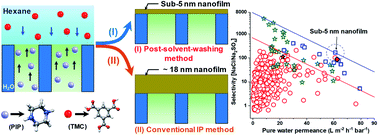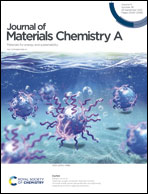Fast water transport through sub-5 nm polyamide nanofilms: the new upper-bound of the permeance–selectivity trade-off in nanofiltration†
Abstract
Liquid transport through a composite membrane is inversely proportional to the thickness of its separation layer. While the scalable fabrication of ultrathin polymer membranes is sought for their commercial exploitation, there is an indispensable need to understand the ion sieving property of ultrathin polymer films. Here, the fabrication of composite membranes with a sub-5 nm thick polyamide nanofilm selective layer fabricated by controlled post-solvent-washing and post-heating of the nascent nanofilm formed via interfacial polymerization of piperazine (PIP) and trimesoyl chloride (TMC) is reported. The post-solvent-washing step removes the unreacted TMC from the surface of the nascent nanofilm and prohibits further growth of the nanofilm during the post-heating process necessary to achieve a desired crosslinked structure. Post-solvent-washing helps design nanofilms with a controlled surface charge and produces the ultrathin separation layer (∼4.5 nm) of the composite membrane. Nanofilm composite membranes show ultrahigh water permeance of 30.1–68.0 L m−2 h−1 bar−1, under a working pressure of 5 bar and showed 96.0–99.82% rejection of a divalent salt (Na2SO4). The monovalent (Cl−) to divalent (SO42−) ion selectivity establishes a global upper-bound of the permeance–selectivity trade-off for the nanofiltration membranes and also delivers an extremely high ion selectivity (1256) in mixed salts.



 Please wait while we load your content...
Please wait while we load your content...